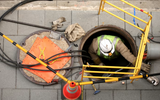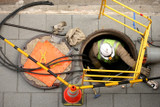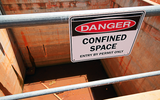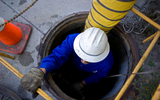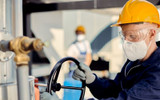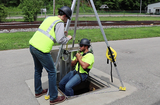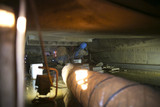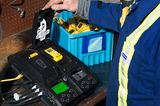Blog
Top 10 Gas Monitors for Confined Spaces
Explore the best gas monitors for confined spaces. Our top 10 picks feature versatile and feature-packed devices to keep workers safe from hazardous gases.
Over the years, confined space gas detection has witnessed tremendous advances. However, confined space gas monitoring is more than finding a reliable device with the most innovative features. To find the most appropriate device for the job, reviewing and understanding workers’ needs and the spaces they’ll be working in is paramount.
…
Dec 4th 2023
Confined Space Rescue Plan
Every workplace needs a
confined space entry and rescue plan to ensure workers know how to stay safe when in spaces unfit for continuous human occupation. Workers may need to go into all types of confined spaces, including storage tanks, utility tunnels, basements, crawl spaces, and manholes. These areas usually have a limited number of entrances/exits, which can make it difficult for workers to escape in an emergency. Water can fill the space, trapping workers inside. The walls or ceil
…
Feb 14th 2023
Hierarchy of Controls for Confined Space
Confined spaces may be difficult and dangerous to work in, but that doesn’t mean that you can’t take steps to make these areas more comfortable or safer. An abundance of caution is always going to be a great tool, but sometimes the easiest and safest thing to do is get rid of hazards contained within the space completely. If that’s not possible, there are more steps to take in the form of the hierarchy of controls. Here is our take on the hierarchy of controls to consider implementing before wor
…
Jul 28th 2021
What’s Your Confined Space Fall Rescue Plan?
Work done in
confined spaces and high places has something in common: the need for fall protection equipment. This gear can help workers avoid falling in the first place, arrest their fall so they don’t hit a lower level, and keep them in place until they can be brought back up. But PPE is the last line of defense in the event of an accident and should be a part of a complete fall rescue plan. Prevent injuries and death by being prepared for fall hazards and confined space dangers.
The
…
Jul 22nd 2021
What Kind of Ventilation is Needed for a Confined Space?
Confined space entry comes with plenty of risks. Basements, storage areas, attics, crawl spaces, sewers, tunnels, and other confined spaces reduce the flow of oxygen, which makes it hard to breathe. That’s why you need to install some form of ventilation to increase the airflow. But not all confined spaces are created alike. There’s a simple formula you can use to figure out exactly how much confined space ventilation is needed while occupying a space. Learn how to protect yourself and your c
…
Feb 11th 2021
Which Gas Detection Device is Right for Your Workplace?
Choosing a gas monitor or detection device depends on the nature of your workplace and how your employees interact with the space. Learn about the pros and cons of different types of gas monitors to make the right choice for your business.
Three Types of Gas Detectors:
Portable gas detectors
Fixed gas detectors
Gas detection tubes (Colorimetric detection devices)
Portable Gas Detectors
Portable gas monitors are designed for employees working in the field or on location.
I
…
Sep 30th 2020
Confined Spaces & COVID-19: Best Practices
Confined spaces are a tight fit, but it is possible to work safely in confined spaces in the ongoing coronavirus pandemic. You’ll need to be more cautious about PPE use, cleaning, and social distancing guidelines, but plenty of caution is crucial for any worksite even when there isn’t a pandemic. What’s important is making sure that contact with contaminated surfaces and people is minimal. When it comes to coronavirus safety, there are three areas that you can look at.
Best Practices
I
…
Aug 27th 2020
FAQs of Fall Safety in Manholes
Working in or around manholes comes with plenty of risks. One of your employees may fall down the hole or they may need help getting back up to the surface. Your team may also encounter hazardous substances down in the sewer, such as hydrogen sulfide, carbon monoxide, and methane. Oxygen and airflow will likely be limited, so you need to make sure you and your team can breathe easy when working in confined spaces.
We get plenty of questions related to manhole safety equipment, so we put
…
Mar 9th 2020
Confined Space Ventilation: What Size Unit Do I Need?
Breathing is an automatic process and a part of our everyday lives, but we don’t think too much about it until we need to. Improper ventilation in a confined space means that workers may breathe in gases and toxins that can cause illness and death. The proper sizing of a blower unit can help you comply with confined space ventilation requirements.When Does Confined Space Ventilation Matter?
Confined space ventilation always matters. OSHA's standard for confined spaces (1910.146 Permit Requi
…
Jan 22nd 2020
How to Re-Calibrate a Gas Detector - Gas Detector Calibration
There are lots of different options to consider when
re-calibrating a gas monitor. Every gas detector is different, so re-calibrating all depends on what kind of monitor you’re working with.
Re-calibration is essential when it comes to the health and safety of your employees.
Gas monitors typically need to be re-calibrated every six months, according to The Occupational Safety and Health Administration (OSHA). You’ll also need to bump test your equipment regularly t
…
Nov 19th 2019


